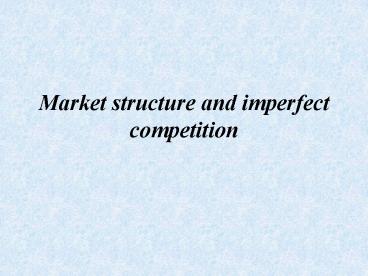Market structure and imperfect competition - PowerPoint PPT Presentation
1 / 22
Title:
Market structure and imperfect competition
Description:
Oligopoly. Monopolistic competition. Features of perfect competition: ... Oligopoly. Interdependence. Collusions; Cartels. Quantity. Price, cost, revenue. Pm. Pc ... – PowerPoint PPT presentation
Number of Views:958
Avg rating:3.0/5.0
Title: Market structure and imperfect competition
1
Market structure and imperfect competition
2
Determinants of market structure
- Number of companies
- Nature of the product homogenous (identical),
differentiated - Freedom of entry and exit
- Barriers to entry
- Control over supply
- Control over price
3
Types of market structure
- Perfect competition
- Monopoly
- Duopoly
- Oligopoly
- Monopolistic competition
4
Features of perfect competition
- Large number of buyers and sellers no
individual seller can influence price - Free entry and exit to industry
- Homogenous product advertisement has no
influence on customers decisions - Perfect information available to buyers and
sellers
5
Advantages of Perfect Competition
- High degree of competition helps allocate
resources to most efficient use - Price marginal costs
- Normal profit made in the long run
- Firms operate at maximum efficiency
- Consumers benefit
6
Monopoly
- A single seller and many buyers
- High barriers to entry (technological,
economical, law-regulated) - Not homogenous products
- Consumer choice limited
- Firm controls price or supply
- Abnormal profits in long run
- Possibility of price discrimination
7
Advantages of monopoly
- May be appropriate if natural monopoly
- Encourages RD
- Encourages Innovation
- Development of some products not
likely without some guarantee of monopoly in
production.
8
- Disadvantages of monopoly
- Exploitation of consumer higher prices
- Potential for supply to be limited- less choicee
9
Monopolistic competition
- Large number of small firms and buyers
- Free entrance and exit to the market
- Differentiated products
- Differentiated product lets firms set prices
- Ease of entry means new competition erodes
profits of firms e.g. pizzerias - Prices can be set by firms to some extend
- The market share of each firm depends on the
price it charges and on the number of firms on
the market
10
Entry and potential competition
- Concerns the effect of potential competition from
new entrants to the industry on the behaviour of
existing firms - Three cases to be distinguished
- Entry is easy
- Entry is difficult by accident
- Entry is difficult by design
11
Entry and potential competition when
Entry is easy
- Contestable market
- market with free entry and free exit
- allows hit-and-run entry (entrant can step in,
make a temporary profit and quit again) - Influence of globalization
- May augment supply, bid down prices and profits
in the domestic markets if monopoly profits are
too high - Foreign firms may set up production facilities in
the home market - Enlarge the relevant market and make entry
easier.
12
Types of entry barriers
- Innocent entry barriers those which are not
deliberately created by alredy operating
companies
- Not innocent entry barriers
Since the level of entry barriers limits the
entrants companies, incumbent firms may try to
influence it, to avoid potential competition.
Entry will be difficult by design.
13
Oligopoly Interdependence
- Collusions
- Cartels.
14
Collusion Agreement to avoid competition
Pm
Price, cost, revenue
ACMC
Pc
DD
MR
Qm
Quantity
15
Profits from collusion
- Profit maximization
- Collusive monopolist
- Desire to compete.
16
CartelsLegal formal agreements
- Common in the late 19th century
- Nowadays prohibited in Europe, USA and other
countries - OPEC the Organization of Petroleum Exporting
Countries (1973)
17
Game theory and interdependent decisions
- A game is a situation in which intelligent
decisions are inevitably dependent on you. - A strategy is a plan describing how a player
acts, or moves in each possible situation
18
John Nash Equilibrium
- Each player chooses the best strategy, but
confronting it's strategy with other players
19
Dominant Strategy
Firm B output
High
Low
1 1
3 0
High
Firm A output
Low
0 3
2 2
20
Dominant Strategies
- A commitment is an arrangement, entered into
voluntarily, that restricts future actions - A credible threat is the one that, after the fact
is still optimal to carry out
21
Summary
22
The end































